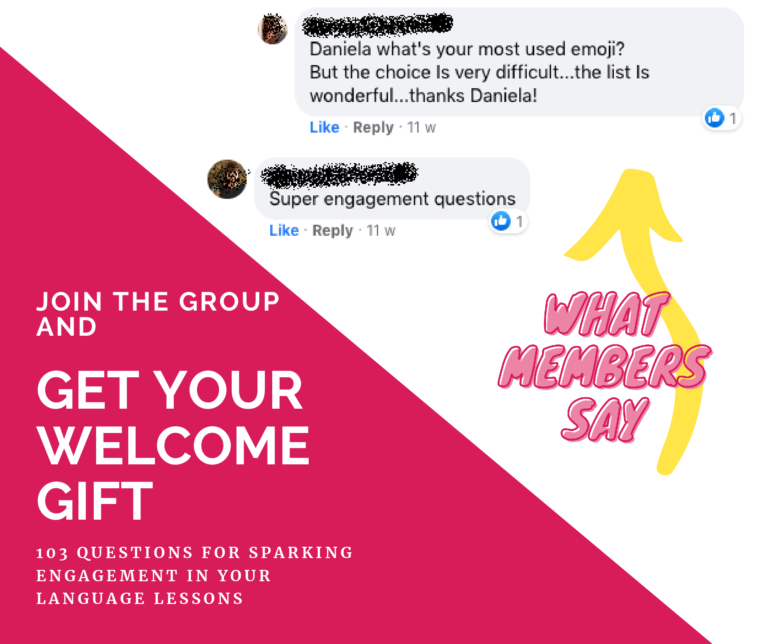
What are the techniques for introducing new vocabulary in language lessons? This article gives a clear framework and ideas to answer the question. The goal is to give you practical guidelines on how to introduce new vocabulary and grammar structures in your second language classes by catching your students’ attention as well.
In this article I’m going to discuss the following hot questions:
- What is the framework for introducing new input?
- What is the motivation phase?
- What is the globality phase?
- What are the techniques for introducing new input?
Furthermore, talking about the techniques:
- What should you expect from the students?
- What are the most common pitfalls (for the teacher)?
- How can we, language teachers, overcome the most common pitfalls?
What is the framework for introducing new input?
In the article How to plan the perfect language lesson I wrote about the Acquisition Unit structure for planning any second language lesson. In this article I would like to take a closer look at the first two phases of the Acquisition Unit, i.e. motivation (engagement) and globality. Why? Because those two phases are relevant for introducing new vocabulary, grammar structures and conversation topics. I take it for granted you adopted the communicative approach to language teaching, for which we introduce any new lexical units within a conversational topic and a communicative context.
What is the motivation phase?
As you read in the article mentioned above, the phase called motivation aims at teasing the students’ curiosity and interest about the conversation topic we’ll be using as means for introducing new input. In other words, in the motivation phase our goal is to explore the communicative context.
What is the globality phase?
The phase called globality aims at introducing the new input for the first time in order to take the students to an overall (global), not-analytical understanding of the new lexical units within their communicative context.
Here is an example for an ESL lesson.
Lexical units we want to introduce: phrasal verbs. For instance:
| 1. to put something in 2. to talk something over 3. to take something out 4. to move in 5. to put something up
| 6. to throw something out 7. to come off 8. to see to something 9. to do something up 10. to think something over |
Topic: moving home, viewing properties.
Communicative context: first viewing of a flat.
The great thing about the Acquisition Unit is that its framework is always valid, regardless of the specific topics we need to introduce. The goal for us, language teachers, is to pitch the new input in a way that we access our students’ interest and attention. How does this work, then? Let’s have a look at that together.
What are the techniques for introducing new input?
The main techniques in the motivation phase are:
- Eliciting
- Brainstorming
- Keywords
- Spidergram
- Mind mapping.
All these techniques aim at answering the following questions:
- What do the students already know about the communicative context and the conversation topic I want to introduce today?
- What knowledge have they already got that I can tap into and that comes from personal experiences?
What to expect (from the students):
Students should elicit personal experiences and their knowledge (words, for instance, or cultural aspects) about the topic you want to introduce.
Common pitfalls (for the teacher):
Not to tease the students enough, to give up if no answers are coming through.
How to overcome the most common pitfalls:
Get ready with a short list of questions about the topic. The goal is to learn more about your students in relation to the topic. A simple question such as ‘Have you ever attended a viewing of a property?’ will enable you to get to know your students a bit better. Another brilliant way to tease curiosity and interest is to address the students’ reflection towards the cultural aspects of a topic. Looking at differences and common aspects in our culture related to a specific topic can really feed the conversation.
Any open-ended question or shared experience activity will do in this phase. If you are not familiar with these activities, you can get more information about them in the free guide Top 5 easy-to-implement strategies for getting your students to speak and engaged:
The techniques in the globality phase are:
- Skim reading
- True/ false
- Multiple choice
- Putting text in order
- Matching
- Taking notes.
All these techniques aim at answering the following questions:
- What is the lesson’s conversational topic about?
- How can I help my students to get a general understanding of the topic?
What to expect (from the students):
Students should get to a very general understanding of the material you chose for presenting the new input (be it a video-clip, a reading text, a dialogue, etc).
Common pitfalls (for the teacher):
To expect the students get to a deeper, more analytical understanding straightaway.
How to overcome the most common pitfalls:
Acquisition can be a quick process, depending on the method you stick to. Regardless of the speed, though, the process is a series of phases and we, language teachers, must respect the gradual flow of the process. Do not rush, be patient. Remember, the brains acquire new knowledge gradually and a global understanding of a topic is the first step in the acquisition process.
Within those guidelines, any techniques or activities that help to answer those questions above will do.
Back to the example above about the phrasal verbs in an ESL class, in the motivation phase we want to help the students to elicit personal experiences with viewings of properties. Alternatively, or in addition, we might help the students to brainstorm the vocabulary they already know related to the topic.
A spontaneous conversation facilitated by the teacher is the most simple activity you ca carry out in the motivation phase.
In the globality phase, we might listen to a dialogue or watch a video where a character attends a property viewing. Afterwards, we might want to launch some exercises for encouraging the global understanding of the material we proposed.
Getting creative
You can really unleash your creativity and turn any activities in the globality phase into a game! If you don’t feel confident enough yet for getting your students involved in games, don’t worry and stick to the common skim reading or matching exercises, for instance.
With regard to the motivation phase, try to stick to the common techniques listed above, at first. In Learn English through Drama courses we approach the motivation phase through drama. Now, you don’t need to start with drama activities straight away if you don’t feel confident in delivering drama exercises. Drama can certainly enrich your toolbox, as long as you feel confident in delivering drama exercises.
That said, if you are looking for fresh ideas for striking up a conversation with your students, then I’ve got something for you! I’m talking about the list 103 questions for sparking engagement in your language classes I specifically created for the language teachers in my Facebook group Independent Language Teachers Collective – get students to speak and engaged.

You are more than welcome to download it for free as you join the group:
Join Facebook Group & Get List
Conclusions
The techniques listed above are the most common activities within motivation and globality phases. Depending on how confident you feel, you might want to get creative and turn them into games or even drama exercises. In this article I meant to focus on the meaning and the purpose of each phase, motivation and globality, in order to make sure the foundations are set, nice and solid for building up playful activities and drama work in the classroom.


